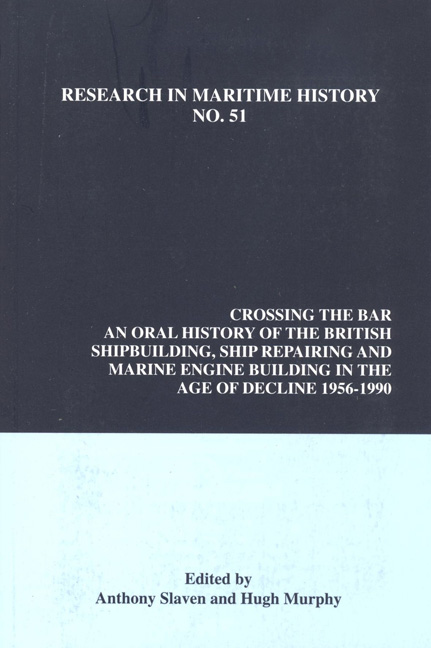 Crossing the Bar
Crossing the Bar Book contents
- Frontmatter
- Contents
- About the Authors
- Dedication
- Preface: A Shipbuilding Libretto
- Introduction
- Interviews
- Lower Clyde
- Upper Clyde
- 4 Sir Eric Yarrow, Weir Engineering, Cathcart, Yarrow Shipbuilders
- 5 Dr. Brian Baxter, Yarrow Shipbuilders
- 6 Bob Easton, Yarrow Shipbuilders
- 7 Sandy Stephen, Alexander Stephen Shipbuilders and Engineers
- 8 Professor John Rorke, Alexander Stephen, Denny Brothers, Brown Brothers
- 9 Fred Walker, Denny Brothers, Fairfield, Connell and Hall Russell
- 10 Jolyon Slogett, Denny Brothers, Houlder Bros., British Shipbuilders Plc
- 11 Dr. John Brown, John Brown, Clydebank
- 12 Graham Strachan, Alexander Stephen, John Brown and Scott Lithgow
- 13 J.F. Starks, John Brown, Upper Clyde Shipbuilders
- 14 Anthony Hepper, Upper Clyde Shipbuilders
- 15 Harry Osborne, Civil Engineer
- The Tyne
- The Wear
- Barrow-in-Furness
- The South Coast
- The Humber
- Belfast
- British Shipbuilding Industry Officials
- The Trade Unions
- The Civil Servants, Board of Trade, Shipbuilding Enquiry Committee, Shipbuilding Industry Board, Ministry of Technology, Department of Trade and Industry, Department of Industry
- The Politicians
- Interviews British Shipbuilders Plc
- Conclusion
- Select Bibliography
12 - Graham Strachan, Alexander Stephen, John Brown and Scott Lithgow
from Upper Clyde
- Frontmatter
- Contents
- About the Authors
- Dedication
- Preface: A Shipbuilding Libretto
- Introduction
- Interviews
- Lower Clyde
- Upper Clyde
- 4 Sir Eric Yarrow, Weir Engineering, Cathcart, Yarrow Shipbuilders
- 5 Dr. Brian Baxter, Yarrow Shipbuilders
- 6 Bob Easton, Yarrow Shipbuilders
- 7 Sandy Stephen, Alexander Stephen Shipbuilders and Engineers
- 8 Professor John Rorke, Alexander Stephen, Denny Brothers, Brown Brothers
- 9 Fred Walker, Denny Brothers, Fairfield, Connell and Hall Russell
- 10 Jolyon Slogett, Denny Brothers, Houlder Bros., British Shipbuilders Plc
- 11 Dr. John Brown, John Brown, Clydebank
- 12 Graham Strachan, Alexander Stephen, John Brown and Scott Lithgow
- 13 J.F. Starks, John Brown, Upper Clyde Shipbuilders
- 14 Anthony Hepper, Upper Clyde Shipbuilders
- 15 Harry Osborne, Civil Engineer
- The Tyne
- The Wear
- Barrow-in-Furness
- The South Coast
- The Humber
- Belfast
- British Shipbuilding Industry Officials
- The Trade Unions
- The Civil Servants, Board of Trade, Shipbuilding Enquiry Committee, Shipbuilding Industry Board, Ministry of Technology, Department of Trade and Industry, Department of Industry
- The Politicians
- Interviews British Shipbuilders Plc
- Conclusion
- Select Bibliography
Summary
I started an engineering apprenticeship the day after I left school in 1950 at Stephen's of Linthouse. After two years, I went to Glasgow University for my first year in engineering. I then went to Cambridge and completed a five-year apprenticeship, combined with a university degree course in 1955. After National Service in the Royal Navy, I obtained a job in the design office of John Brown's at Clydebank. In 1963, I was appointed Technical Director, and shortly afterwards I became Engineering Director at the age of thirty-one. I remained there until 1966, when, following the recommendations of the Geddes Report, engineering was separated from shipbuilding. I initially became Director and General Manager, and latterly Managing Director of John Brown Engineering. I left in 1984 to take up a position with Trafalgar House, when they acquired the Scott Lithgow yard.
When I came back from my National Service in 1957, I remember that the order books at John Brown stretched well into the early 1960s. John Brown at any one time could be building a large passenger ship, a couple of tankers, a couple of bulk carriers and so on. They had an incredible mix of products. That was seen as strength by some and a weakness by others, because one could say that had they concentrated on one type of vessel they could have done a lot better, rather than dispersing their activities and resources over a range of products. One of the weaknesses arising from this was that everything was made to the highest quality demanded by the one type, whether that was a passenger ship or a naval ship. So a bulk carrier was constructed with too high a finish than was absolutely necessary. The problem was that the owners expected a very high standard of finish from a yard like John Brown, whereas they would have accepted a lower standard from the Lower Clyde, which only made this type of ship, and did not build passenger ships. [Historically, the Lower Clyde yards did build passenger ships, and the districtdid not concentrate on one type of ship]. It was impossible for the workforce to work on dual standard of quality. They tended to work to the highest, and the ship owner insisted on the John Brown standard.
- Type
- Chapter
- Information
- Crossing the BarAn Oral History of the British Shipbuilding, Ship Repairing and Marine Engine-Building Industries in the Age of Decline, 1956-1990, pp. 47 - 51Publisher: Liverpool University PressPrint publication year: 2013


